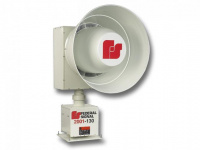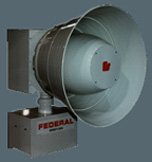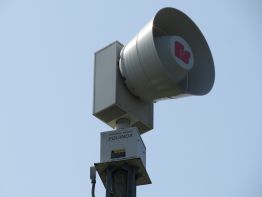2001: Difference between revisions
ArxCyberwolf (talk | contribs) (Updated Equinox section.) |
ArxCyberwolf (talk | contribs) mNo edit summary |
||
| Line 17: | Line 17: | ||
=== Model 2001-SRN (1988-2002) === | === Model 2001-SRN (1988-2002) === | ||
[[File:Capture.PNG|thumb|right|The 2001-SRN 1st generation "Roundback" (left) and 2nd generation "Squareback" (right) variants.| | [[File:Capture.PNG|thumb|right|The 2001-SRN 1st generation "Roundback" (left) and 2nd generation "Squareback" (right) variants.|263x263px]]The '''Model 2001-SRN''' was the earliest model of Model 2001 produced, being introduced into Federal Signal's lineup in 1988. The Model 2001-SRN was introduced as a potential replacement for the Thunderbolt, as a lower maintenance, DC capable siren. The earliest Model 2001 sirens were known as "Roundback" Model 2001-SRNs. Rather than using the square housing of later Model 2001s, these 1st generation Model 2001-SRN units use a rounded housing, with "FEDERAL 2001-DC" stickers advertising the siren's DC power capabilities on the rotator. A three-signal variant was offered, though none were ever sold. | ||
The nose cone is conical, and inside of the nose cone is a 6 hp 48 V DC motor, and the siren reuses the Thunderbolt's belt-driven rotator, which allows the rotation speed to be adjustable from 2, 4, or 8 rpm. They have a mesh screen on the front of the horn, which helps keep debris out. The Model 2001-SRN is able to reach 126 dB at 100 ft. These would be sold until 1990, when it was replaced by the 2nd generation Model 2001-SRN "Squareback" design. The only change between the 1st generation and early 2nd generation Model 2001s is the housing, keeping everything else the same. The 2nd generation SRNs kept the "2001-DC" stickers, although their official name was still the Model 2001-SRN.[[File:Official 2001SRN.jpg|thumb|162x162px|A 3rd generation 2001-SRN.]]These would be sold until 1996, when the Model 2001-SRN received another redesign, the 3rd generation. The horn was changed slightly where it attached to the "throats" due to a stator design change, and the horn was made slightly larger, with a two-piece horn instead of the older single piece horn. Early 3rd generation units used the old nose cone from the 2nd generation Model 2001-SRN, before it was switched to the larger, rounder nose cone that the rest of the Model 2001 series would use. The mesh screen would also be relocated, now being located in front of the 12 throat holes. This was due to the older mesh screens often being damaged and falling off. These would be sold until 1998. | The nose cone is conical, and inside of the nose cone is a 6 hp 48 V DC motor, and the siren reuses the Thunderbolt's belt-driven rotator, which allows the rotation speed to be adjustable from 2, 4, or 8 rpm. They have a mesh screen on the front of the horn, which helps keep debris out. The Model 2001-SRN is able to reach 126 dB at 100 ft. These would be sold until 1990, when it was replaced by the 2nd generation Model 2001-SRN "Squareback" design. The only change between the 1st generation and early 2nd generation Model 2001s is the housing, keeping everything else the same. The 2nd generation SRNs kept the "2001-DC" stickers, although their official name was still the Model 2001-SRN.[[File:Official 2001SRN.jpg|thumb|162x162px|A 3rd generation 2001-SRN.]]These would be sold until 1996, when the Model 2001-SRN received another redesign, the 3rd generation. The horn was changed slightly where it attached to the "throats" due to a stator design change, and the horn was made slightly larger, with a two-piece horn instead of the older single piece horn. Early 3rd generation units used the old nose cone from the 2nd generation Model 2001-SRN, before it was switched to the larger, rounder nose cone that the rest of the Model 2001 series would use. The mesh screen would also be relocated, now being located in front of the 12 throat holes. This was due to the older mesh screens often being damaged and falling off. These would be sold until 1998. | ||
| Line 39: | Line 39: | ||
=== Model Equinox (2010-present) === | === Model Equinox (2010-present) === | ||
[[File:Perry NGS Equinox.JPG|thumb|262x262px|A Federal Signal 2001-Equinox in Mentor, OH, part of the Perry Nuclear Power Plant Siren System.]] | |||
While not officially part of the 2001 family, the '''Model Equinox''' shares many characteristics of its design with the 2001-130, essentially being a [[Federal Signal 2001|2001-130]] with an [[Federal Signal Model ECLIPSE|Eclipse-8]] rotor and 8-port stator. The 2001-Equinox can be difficult to visibly differentiate from the 2001-130 as they look nearly identical, besides the "EQUINOX" sticker replacing "2001-130" on the rotator box. However, if one looks closely, the stators are noticeably different on the 2 models. The 2001-130 has 12 individual projectors on the stator with narrow gaps between them, where the 2001-Equinox only has 8 with rather large gaps between them. In 2014, the Equinox was publicly introduced as a low tone option to the 2001 series and is still available today. Despite this, only around 200 units have been produced as of 2021. | While not officially part of the 2001 family, the '''Model Equinox''' shares many characteristics of its design with the 2001-130, essentially being a [[Federal Signal 2001|2001-130]] with an [[Federal Signal Model ECLIPSE|Eclipse-8]] rotor and 8-port stator. The 2001-Equinox can be difficult to visibly differentiate from the 2001-130 as they look nearly identical, besides the "EQUINOX" sticker replacing "2001-130" on the rotator box. However, if one looks closely, the stators are noticeably different on the 2 models. The 2001-130 has 12 individual projectors on the stator with narrow gaps between them, where the 2001-Equinox only has 8 with rather large gaps between them. In 2014, the Equinox was publicly introduced as a low tone option to the 2001 series and is still available today. Despite this, only around 200 units have been produced as of 2021. | ||
Revision as of 19:46, 14 August 2024
| Federal Signal Model 2001 | |
 2001-130 | |
| Company | Federal Signal Corporation |
|---|---|
| Produced | 1988-present |
| Type | Rotational Electromechanical |
| Sound output | 125-130 dB @ 100 ft |
| Horsepower | 6-6.5 hp |
| Voltage | 48 V DC |
| Preceded by | Federal Signal Thunderbolt |
| Documentation | Manual |
The Model 2001 is a series of DC-powered rotating mechanical sirens produced by Federal Signal over the past 30+ years, as a replacement to Federal's popular but aging Thunderbolt series.
Boasting a very high sound output with battery backup capabilities, the Model 2001 series has become one of, if not the most popular option for cities seeking a DC siren system all across the country. It competes with ASC's T-128 as the most popular rotating mechanical siren on the market.
Design
While the Model 2001 series has gone through many changes over the years, all Model 2001 sirens take the same general form. The siren's rotor and stator are located in the horn, just behind the nose cone. Unlike nearly every other siren, the chopper on the Model 2001 faces backwards, with the siren's 6.5 hp (originally 6 hp) 48 V DC motor being located inside the nose cone.
The rotor and stator are the exact same as Federal's long-discontinued C1 1/2 Model 3, coming exclusively in 12-port single tone with small "throats" attached to the stator ports which direct the sound up and forwards out into the horn of the siren. This design is what gives the Model 2001 its distinctive "rasp" and allows the siren to boast significant sound output without the need for a blower or high-powered motor.
This is all attached to the square/rectangular main housing located behind the horn, which contains the collector ring tube and wiring, with the siren's dual intakes being located on the bottom of the housing, protected by mesh screens. The top of the housing has a slightly pyramid-shaped protrusion, which prevents rainwater from pooling on top of the housing and rusting through.
The collector ring tube is reused from the Thunderbolt in all models. The Model 2001's rotator is located below the housing and has seen the most changes over the siren's production. All Model 2001 sirens include and run on Federal's FC controller. Since its production began in 1988, the Model 2001 has been produced in several different forms, with four distinct models:
History
Model 2001-SRN (1988-2002)

The Model 2001-SRN was the earliest model of Model 2001 produced, being introduced into Federal Signal's lineup in 1988. The Model 2001-SRN was introduced as a potential replacement for the Thunderbolt, as a lower maintenance, DC capable siren. The earliest Model 2001 sirens were known as "Roundback" Model 2001-SRNs. Rather than using the square housing of later Model 2001s, these 1st generation Model 2001-SRN units use a rounded housing, with "FEDERAL 2001-DC" stickers advertising the siren's DC power capabilities on the rotator. A three-signal variant was offered, though none were ever sold. The nose cone is conical, and inside of the nose cone is a 6 hp 48 V DC motor, and the siren reuses the Thunderbolt's belt-driven rotator, which allows the rotation speed to be adjustable from 2, 4, or 8 rpm. They have a mesh screen on the front of the horn, which helps keep debris out. The Model 2001-SRN is able to reach 126 dB at 100 ft. These would be sold until 1990, when it was replaced by the 2nd generation Model 2001-SRN "Squareback" design. The only change between the 1st generation and early 2nd generation Model 2001s is the housing, keeping everything else the same. The 2nd generation SRNs kept the "2001-DC" stickers, although their official name was still the Model 2001-SRN.

These would be sold until 1996, when the Model 2001-SRN received another redesign, the 3rd generation. The horn was changed slightly where it attached to the "throats" due to a stator design change, and the horn was made slightly larger, with a two-piece horn instead of the older single piece horn. Early 3rd generation units used the old nose cone from the 2nd generation Model 2001-SRN, before it was switched to the larger, rounder nose cone that the rest of the Model 2001 series would use. The mesh screen would also be relocated, now being located in front of the 12 throat holes. This was due to the older mesh screens often being damaged and falling off. These would be sold until 1998.
The final redesign of the Model 2001-SRN would occur in 1998 as the final and 4th generation, with the housing and rotator becoming slimmer, with the 8 RPM rotation speed option being removed. The "2001-DC" stickers were no longer used, with the siren now being referred to only as the Model 2001-SRN. The 4th generation Model 2001-SRN would be sold until 2002, when it was replaced by the Model 2001-SRNB, which offered better performance and required less maintenance.
Model 2001-SRNs of all generations are still very common to find in service, including several roundback units. The Model 2001-SRN was able to match the Thunderbolt's sound output without the need for a blower and with battery backup, causing the Model 2001-SRN to completely replace the Thunderbolt in 1990.
Do note that while the stickers on many Model 2001-SRNs say "2001-DC", the Model 2001-SRN is NOT named the Model 2001-DC. "2001-DC" refers to the fact that Model 2001 sirens are DC powered, and any Model 2001 siren running on DC power is a Model 2001-DC, while Model 2001s running on an AC rectifier are Model 2001-ACs. "Model 2001-DC" was the name used by Federal Signal to advertise the siren's then-new DC powered capabilities, which is why many Model 2001-SRNs had "2001-DC" stickers.
Model 2001-SRNB (2002-2006)
The Model 2001-SRNB (Model 2001-SRN, Beltless) was the successor of the Model 2001-SRN, introduced in 2002. The Model 2001-SRNB is a 5th generation Model 2001-SRN with a new rotator. Rather than using the rectangular belt-driven rotator from the Thunderbolt like the Model 2001-SRN did, the Model 2001-SRNB introduced a new cube-shaped direct-drive rotator, eliminating the need for belts and making the siren more maintenance-free. The rotator runs at 2 RPM from factory, and is adjustable up to 6 RPM. The DC motor is directly coupled to the gear reducer, which then spins the rotator's main gear. The chopper motor was also upgraded from 6 hp to 6.5 hp, which increased the siren's sound output to 128 dB at 100 ft.
The Model 2001-SRNB also introduced the decals that every later Model 2001 would use. Early Model 2001-SRNBs used the smaller FS logo from the Model 2001-SRN, but this was updated to the larger logo in 2004. The Model 2001-SRNB had the shortest production run, only being produced for 4 years from 2002 until 2006. Despite this, it still proved to be popular and is still a common find.
Model 2001-130 (2006-present)

The Model 2001-130 is the 6th Generation, newest and best performing in the official Model 2001 series of sirens and is the current model of Model 2001 in production as of today. The Model 2001-130 is identical to a Model 2001-SRNB in every way except for it's housing. Rather than using the square housing of the Model 2001-SRN and SRNB, the Model 2001-130's housing is taller and rectangular in shape. This is a correction for a design flaw of previous Model 2001 sirens, where the collector ring assembly and support beam for the housing blocked the chopper's intake partially, hindering performance. The Model 2001-130's taller housing allows for the chopper to now be above the collector ring and support assemblies, which greatly improves airflow to the chopper and increasing the siren's output to 130 dB at 100 ft.
The Model 2001-130 is easily the most popular siren in the series, with systems of Model 2001-130s being installed all across the country and often replacing older systems and is still being produced today.
Model Equinox (2010-present)

While not officially part of the 2001 family, the Model Equinox shares many characteristics of its design with the 2001-130, essentially being a 2001-130 with an Eclipse-8 rotor and 8-port stator. The 2001-Equinox can be difficult to visibly differentiate from the 2001-130 as they look nearly identical, besides the "EQUINOX" sticker replacing "2001-130" on the rotator box. However, if one looks closely, the stators are noticeably different on the 2 models. The 2001-130 has 12 individual projectors on the stator with narrow gaps between them, where the 2001-Equinox only has 8 with rather large gaps between them. In 2014, the Equinox was publicly introduced as a low tone option to the 2001 series and is still available today. Despite this, only around 200 units have been produced as of 2021.
The Model Equinox was introduced in 2010. Initially, these sirens were rolled out on special order to the nuclear power plant market that had wanted sirens with a lower peak pitch (500hz, 8-port) than a 2001-130 that would in theory have a longer range and penetration due to the lower frequency. The Equinox was a bit of a rush job, as Federal had little time to design the siren. Unfortunately, because of the design of the Model ECLIPSE's rotor (which has an integral intake "cone"), it sticks out into the housing, which severely hampered airflow to the chopper and reduced the siren's output to 125 dB at 100 ft, even worse than the 2001-SRN. Federal would learn from this mistake and would later produce the Model 508-128, which would solve the flaws with the Model Equinox's design while also being 500 hz and boasting a significant improvement in output in comparison.
The first system of 2001-Equinox sirens were installed in 2010 around the Beaver Valley Power Station in Shippingport, Pennsylvania, a nuclear plant operated at the time by FirstEnergy Nuclear. The next system was installed at another FENOC plant, Perry, beginning in 2012. While these are considered to be the first installation of 2001-Equinoxes, one was installed in New Carlisle, Ohio in 2010, so it is possible that municipalities were able to order the 2001-Equinox on special request as well during this period. In 2021, Lansing, Michigan, received a number of 2001-Equinoxes to replace their aging system; the largest system of 2001-Equinoxes to be installed since the nuclear plant installations.
Despite the Model 508-128 being much better than the Model Equinox, the siren continues to be sold today alongside the Model 2001-130 and the Model 508-128 as a lower-cost, special-order siren. Like the Model 508-128, the Model Equinox competes with ASC's Tempest-128.
Controllers
The current controllers that Federal Signal sells to operate the siren are the DCFCB and 2001-AC which are used for 120VAC power and 208 or 220/240VAC respectively. Both controllers have NEMA 4X aluminum cabinets with 2 48VDC chargers.[1] 2001-DC used to be the name used for the DC controller sold for the siren and is where the nickname for the 2nd gen 2001-SRNs (the ones with the 2001-DC sticker) came from.[2]